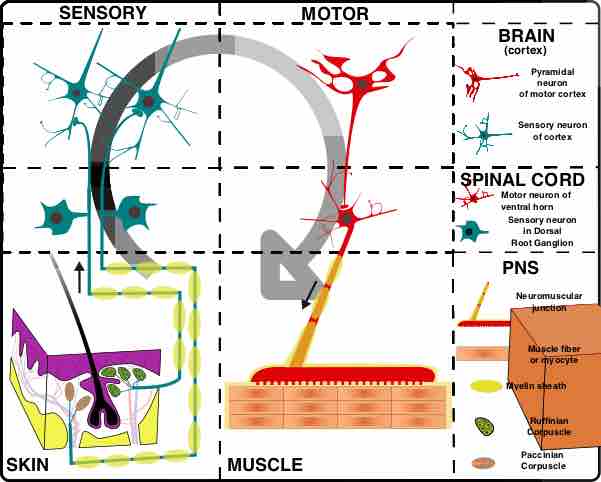Direction of Nerve Impulse
There are several ways in which neurons are functionally classified. The most straightforward classification is by the direction the action potentials (i.e. information) travel. Afferent neurons convey information from tissues and organs into the central nervous system (e.g. sensory neurons). Efferent neurons transmit signals from the central nervous system to the effector cells (e.g. motor neurons). Afferent and efferent also refer generally to neurons that bring information to or send information from a brain region. Interneurons connect neurons within specific regions of the central nervous system .

The organization of the nervous system
Gross organization of the nervous system, with the peripheral nervous system, the spinal, and the cortical levels.
Neurotransmitter Type
Another way in which neurons are classified is by their effect on target neurons. A neuron releases a neurotransmitter that binds to chemical receptors on the target neuron . The combination of neurotransmitter and receptor properties results in an excitatory, inhibitory, or modulatory change to the target neuron. For example, the two most common neurotransmitters in the brain (90% of neurons), glutamate and GABA, have opposing actions. Glutamate acts on several different types of receptors, and has effects that are largely excitatory. GABA acts on several different classes of receptors, exerting inhibitory effects. Other types of neurons include excitatory motor neurons in the spinal cord that release acetylcholine, and inhibitory spinal neurons that release glycine.
Major elements in neuron-to-neuron communication
Electrical impulses travel along the axon of a neuron. When this signal reaches a synapse, it provokes release of neurotransmitter molecules, which bind to receptor molecules located in the the target cell.
Firing Properties
A third less common method of neuron classification is according to their electrophysiological characteristics. Neurons that are typically constantly (or tonically) active are called tonic or regular spiking. Neurons that are intermittently active are called phasic or bursting. And finally neurons with high activity rates are called fast spiking.